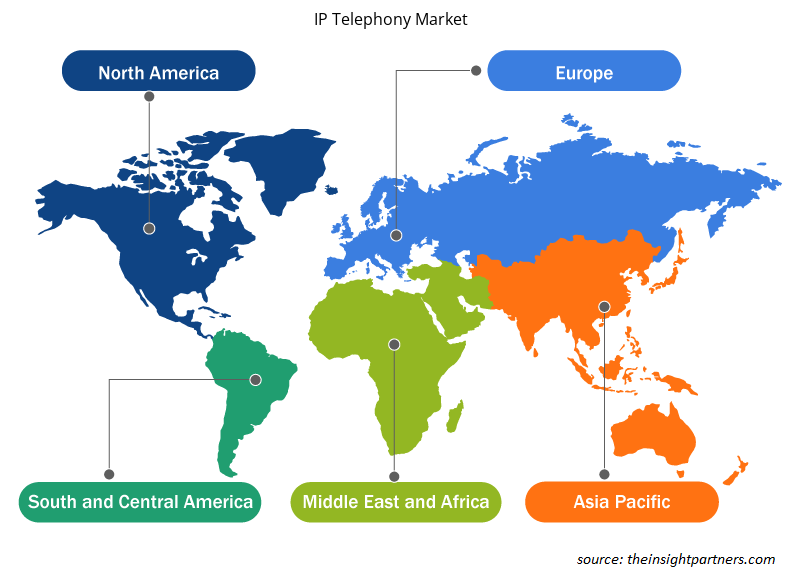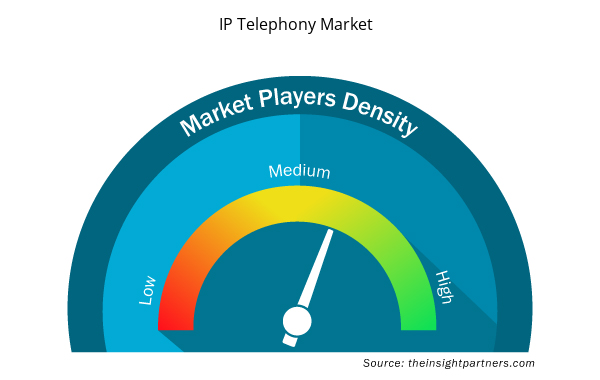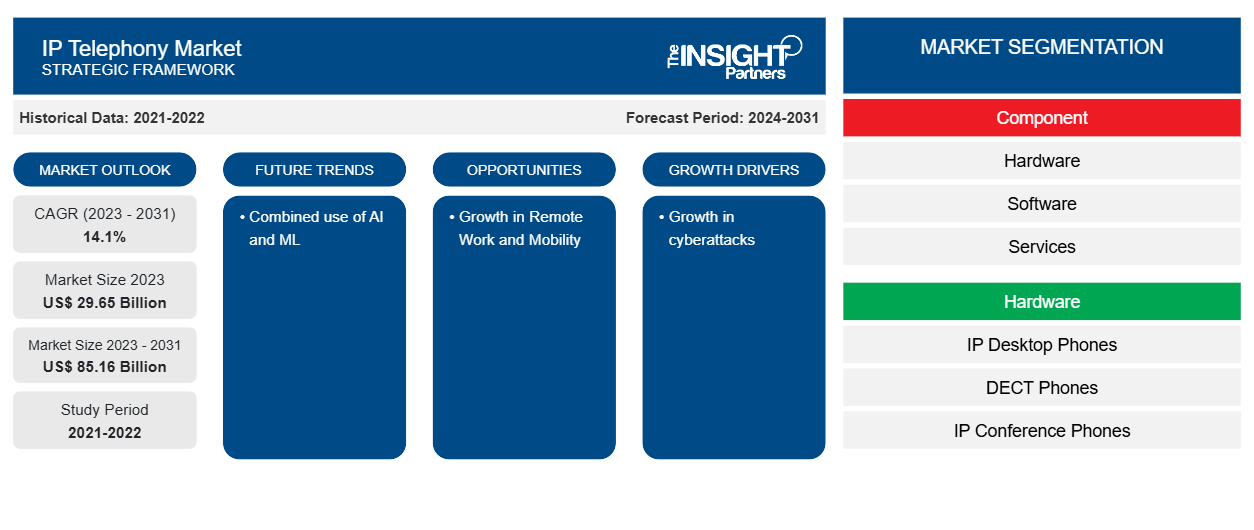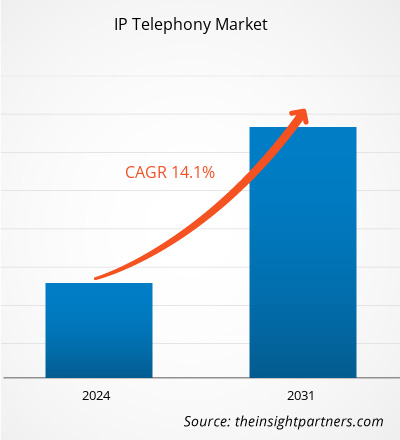Se proyecta que el tamaño del mercado de telefonía IP alcance los 85.160 millones de dólares en 2031, frente a los 29.650 millones de dólares en 2023. Se espera que el mercado de telefonía IP registre una CAGR del 14,1 % durante el período 2023-2031. La voz sobre IP (VoIP) es un servicio y una aplicación que se incluye en el ámbito de la telefonía IP. Es la transmisión de comunicaciones de voz a través de redes IP.
Análisis del mercado de telefonía IP
La telefonía con protocolo de Internet (IP) ofrece una variedad de servicios, como llamadas de voz, videollamadas, correo de voz, fax, mensajería instantánea (1M) y videoconferencias. La telefonía IP, a diferencia de VolP, a menudo ofrece más que solo funciones de voz. La telefonía IP beneficia a organizaciones de todos los tamaños al proporcionar una red combinada para funciones de teléfono e Internet. La telefonía IP ofrece costos más bajos, infraestructura más simple, escalabilidad y movilidad, lo que la hace atractiva para los usuarios finales.
Panorama del mercado de telefonía IP
La telefonía IP se refiere a cualquier sistema que se enmarca dentro de las telecomunicaciones basadas en Internet, incluyendo el fax y otras tecnologías. Utiliza una variedad de protocolos de código abierto para enviar datos desde el teléfono al proveedor de servicios. Las empresas están implementando rápidamente soluciones de telefonía IP debido a su portabilidad y rentabilidad. Además, los sistemas de telefonía IP son fáciles de usar, ofrecen tecnologías avanzadas y aumentan la productividad. Estos factores están impulsando la adopción de sistemas de telefonía IP. La telefonía IP agrega una nueva característica a los teléfonos comerciales y mejora la comunicación al brindar una solución rentable, lo que se considera un factor clave para el mercado mundial de telefonía IP. Los sistemas y hardware heredados existentes, como máquinas de fax , lectores de tarjetas de crédito y alarmas, se pueden vincular fácilmente con los sistemas de telefonía IP.
Personalice este informe según sus necesidades
Obtendrá personalización en cualquier informe, sin cargo, incluidas partes de este informe o análisis a nivel de país, paquete de datos de Excel, así como también grandes ofertas y descuentos para empresas emergentes y universidades.
- Obtenga las principales tendencias clave del mercado de este informe.Esta muestra GRATUITA incluirá análisis de datos, desde tendencias del mercado hasta estimaciones y pronósticos.
Factores impulsores y oportunidades del mercado de telefonía IP
Aumento de ciberataques favorece al mercado
Los rápidos avances tecnológicos han provocado un aumento de las vulnerabilidades en los últimos años. Las empresas recurren cada vez más a los productos y servicios de telefonía IP a medida que los ciberataques se vuelven más comunes. IBM estima que el coste total de las violaciones de datos en las empresas será de aproximadamente 6 billones de dólares solo en 2021. Se espera que las cifras aumenten durante el período previsto. Por lo tanto, las empresas están implementando soluciones de telefonía IP para proteger los datos y prevenir las violaciones, lo que se espera que impulse la CAGR del mercado de telefonía IP durante el período previsto.cyberattacks become more common. IBM estimates that the total cost of data breaches in enterprises will be approximately US$ 6 trillion in 2021 alone. The numbers are expected to rise during the anticipated timeframe. Hence, businesses are deploying IP telephony solutions to protect data and prevent breaches, which is expected to boost the IP telephony market CAGR throughout the forecast period.
Aumento de la cultura del trabajo remoto
El uso cada vez mayor de dispositivos móviles y la creciente adopción de una cultura de trabajo remoto están impulsando la demanda de soluciones de telefonía IP adaptables y de rápida disponibilidad. Los empleados utilizan cada vez más aplicaciones de teléfonos inteligentes para realizar y recibir llamadas desde cualquier lugar. Además, la colaboración remota requiere comunicación con software de videoconferencia. Los proveedores de telefonía IP se están centrando en desarrollar soluciones que aborden estas necesidades en constante evolución.
Informe de mercado de telefonía IP Análisis de segmentación
Los segmentos clave que contribuyeron a la derivación del análisis del mercado de telefonía IP son componentes, hardware, servicio, tipo de instalación, tipo de empresa y usuarios finales.
- Según los componentes, el mercado de telefonía IP se divide en hardware, software y servicios.
- Por hardware, el mercado está segmentado en teléfonos de escritorio IP, teléfonos DECT y teléfonos de conferencia IP.
- Según el servicio, el mercado de telefonía IP se divide en instalación y mantenimiento y servicios profesionales.
- Según el tipo de instalación, el mercado de telefonía IP se segmenta en cableado e inalámbrico.
- Según el tamaño de la empresa, el mercado de telefonía IP se segmenta en pymes y grandes empresas.
- Según los usuarios finales, el mercado de telefonía IP está segmentado en organizaciones residenciales, corporativas y gubernamentales.
Análisis de la cuota de mercado de telefonía IP por geografía
El alcance geográfico del informe de mercado de telefonía IP se divide principalmente en cinco regiones: América del Norte, Asia Pacífico, Europa, Oriente Medio y África, y América del Sur y Central. Las causas implicadas se derivan de los aumentos globales en la adopción de aplicaciones de telefonía IP y el avance tecnológico. Estas aplicaciones a menudo se crean en ciertos sectores industriales, como BFSI, atención médica, comercio minorista, TI y telecomunicaciones. Además, se espera que el crecimiento de la región sea impulsado por el uso generalizado de servicios de telefonía IP, infraestructura de telecomunicaciones de vanguardia y el atractivo de la movilidad laboral.
Perspectivas regionales del mercado de telefonía IP
Los analistas de Insight Partners explicaron en detalle las tendencias y los factores regionales que influyen en el mercado de telefonía IP durante el período de pronóstico. Esta sección también analiza los segmentos y la geografía del mercado de telefonía IP en América del Norte, Europa, Asia Pacífico, Oriente Medio y África, y América del Sur y Central.

- Obtenga los datos regionales específicos para el mercado de telefonía IP
Alcance del informe sobre el mercado de telefonía IP
| Atributo del informe | Detalles |
|---|---|
| Tamaño del mercado en 2023 | US$ 29,65 mil millones |
| Tamaño del mercado en 2031 | US$ 85,16 mil millones |
| CAGR global (2023 - 2031) | 14,1% |
| Datos históricos | 2021-2022 |
| Período de pronóstico | 2024-2031 |
| Segmentos cubiertos | Por componente
|
| Regiones y países cubiertos | América del norte
|
| Líderes del mercado y perfiles de empresas clave |
|
Densidad de actores del mercado de telefonía IP: comprensión de su impacto en la dinámica empresarial
El mercado de telefonía IP está creciendo rápidamente, impulsado por la creciente demanda de los usuarios finales debido a factores como la evolución de las preferencias de los consumidores, los avances tecnológicos y una mayor conciencia de los beneficios del producto. A medida que aumenta la demanda, las empresas amplían sus ofertas, innovan para satisfacer las necesidades de los consumidores y aprovechan las tendencias emergentes, lo que impulsa aún más el crecimiento del mercado.
La densidad de actores del mercado se refiere a la distribución de las empresas o firmas que operan dentro de un mercado o industria en particular. Indica cuántos competidores (actores del mercado) están presentes en un espacio de mercado determinado en relación con su tamaño o valor total de mercado.
Las principales empresas que operan en el mercado de telefonía IP son:
- Compañía: Avaya Inc.
- Sistemas operativos de Cisco
- Comunicaciones Gigaset
- LG Electronics Inc.
- Corporación Mitel Networks
- Corporación Panasonic
Descargo de responsabilidad : Las empresas enumeradas anteriormente no están clasificadas en ningún orden particular.

- Obtenga una descripción general de los principales actores clave del mercado de telefonía IP
Noticias y desarrollos recientes del mercado de telefonía IP
El mercado de telefonía IP se evalúa mediante la recopilación de datos cualitativos y cuantitativos a partir de investigaciones primarias y secundarias, que incluyen importantes publicaciones corporativas, datos de asociaciones y bases de datos. A continuación, se enumeran algunos de los avances en el mercado de telefonía IP:
- Broadvoice, proveedor de servicios de voz alojados, comunicaciones unificadas y trunking SIP, ganó el premio al Producto de telefonía por Internet del año 2022. Durante los últimos 23 años, el premio ha honrado y reconocido los productos y servicios de comunicación VoIP e IP.
(Fuente: Broadvoice, comunicado de prensa, marzo de 2022)
- Pure IP ofrece comunicaciones de voz globales para empresas. Ahora se puede acceder a ellas a través del sistema Zoom Phone Provider Exchange. Los clientes tendrán mayor libertad con este programa. Conservará Pure IP mientras utiliza su red de telecomunicaciones en otros lugares.
(Fuente: Pure IP, nota de prensa, abril de 2023)
Informe sobre el mercado de telefonía IP: cobertura y resultados
El informe "Tamaño y pronóstico del mercado de telefonía IP (2021-2031)" proporciona un análisis detallado del mercado que cubre las siguientes áreas:
- Tamaño del mercado de telefonía IP y pronóstico a nivel global, regional y nacional para todos los segmentos clave del mercado cubiertos bajo el alcance
- Tendencias del mercado de telefonía IP, así como dinámicas del mercado, como impulsores, restricciones y oportunidades clave
- Análisis detallado de las cinco fuerzas de Porter y PEST y FODA
- Análisis del mercado de telefonía IP que abarca las tendencias clave del mercado, el marco global y regional, los principales actores, las regulaciones y los desarrollos recientes del mercado
- Panorama de la industria y análisis de la competencia que abarca la concentración del mercado, análisis de mapas de calor, actores destacados y desarrollos recientes para el mercado de telefonía IP
- Perfiles detallados de empresas
- Análisis histórico (2 años), año base, pronóstico (7 años) con CAGR
- Análisis PEST y FODA
- Tamaño del mercado Valor/volumen: global, regional, nacional
- Industria y panorama competitivo
- Conjunto de datos de Excel



Report Coverage
Revenue forecast, Company Analysis, Industry landscape, Growth factors, and Trends

Segment Covered
This text is related
to segments covered.

Regional Scope
North America, Europe, Asia Pacific, Middle East & Africa, South & Central America

Country Scope
This text is related
to country scope.
Preguntas frecuentes
The global IP telephony market is expected to reach US$ 85.16 billion by 2031.
The key players holding majority shares in the global IP telephony market are Avaya Inc., Cisco Systems Inc., Gigaset Communications, LG Electronics Inc., and Mitel Networks Corporation.
The combined use of AI and ML is anticipated to play a significant role in the global IP telephony market in the coming years.
The increase in cyberattacks is the major factor propelling the global IP telephony market.
The global IP telephony market was estimated to be US$ 29.65 billion in 2023 The market is expected to register a CAGR of 14.1% during 2023–2031.
Trends and growth analysis reports related to Technology, Media and Telecommunications : READ MORE..
The Insight Partners performs research in 4 major stages: Data Collection & Secondary Research, Primary Research, Data Analysis and Data Triangulation & Final Review.
- Data Collection and Secondary Research:
As a market research and consulting firm operating from a decade, we have published and advised several client across the globe. First step for any study will start with an assessment of currently available data and insights from existing reports. Further, historical and current market information is collected from Investor Presentations, Annual Reports, SEC Filings, etc., and other information related to company’s performance and market positioning are gathered from Paid Databases (Factiva, Hoovers, and Reuters) and various other publications available in public domain.
Several associations trade associates, technical forums, institutes, societies and organization are accessed to gain technical as well as market related insights through their publications such as research papers, blogs and press releases related to the studies are referred to get cues about the market. Further, white papers, journals, magazines, and other news articles published in last 3 years are scrutinized and analyzed to understand the current market trends.
- Primary Research:
The primarily interview analysis comprise of data obtained from industry participants interview and answers to survey questions gathered by in-house primary team.
For primary research, interviews are conducted with industry experts/CEOs/Marketing Managers/VPs/Subject Matter Experts from both demand and supply side to get a 360-degree view of the market. The primary team conducts several interviews based on the complexity of the markets to understand the various market trends and dynamics which makes research more credible and precise.
A typical research interview fulfils the following functions:
- Provides first-hand information on the market size, market trends, growth trends, competitive landscape, and outlook
- Validates and strengthens in-house secondary research findings
- Develops the analysis team’s expertise and market understanding
Primary research involves email interactions and telephone interviews for each market, category, segment, and sub-segment across geographies. The participants who typically take part in such a process include, but are not limited to:
- Industry participants: VPs, business development managers, market intelligence managers and national sales managers
- Outside experts: Valuation experts, research analysts and key opinion leaders specializing in the electronics and semiconductor industry.
Below is the breakup of our primary respondents by company, designation, and region:

Once we receive the confirmation from primary research sources or primary respondents, we finalize the base year market estimation and forecast the data as per the macroeconomic and microeconomic factors assessed during data collection.
- Data Analysis:
Once data is validated through both secondary as well as primary respondents, we finalize the market estimations by hypothesis formulation and factor analysis at regional and country level.
- Macro-Economic Factor Analysis:
We analyse macroeconomic indicators such the gross domestic product (GDP), increase in the demand for goods and services across industries, technological advancement, regional economic growth, governmental policies, the influence of COVID-19, PEST analysis, and other aspects. This analysis aids in setting benchmarks for various nations/regions and approximating market splits. Additionally, the general trend of the aforementioned components aid in determining the market's development possibilities.
- Country Level Data:
Various factors that are especially aligned to the country are taken into account to determine the market size for a certain area and country, including the presence of vendors, such as headquarters and offices, the country's GDP, demand patterns, and industry growth. To comprehend the market dynamics for the nation, a number of growth variables, inhibitors, application areas, and current market trends are researched. The aforementioned elements aid in determining the country's overall market's growth potential.
- Company Profile:
The “Table of Contents” is formulated by listing and analyzing more than 25 - 30 companies operating in the market ecosystem across geographies. However, we profile only 10 companies as a standard practice in our syndicate reports. These 10 companies comprise leading, emerging, and regional players. Nonetheless, our analysis is not restricted to the 10 listed companies, we also analyze other companies present in the market to develop a holistic view and understand the prevailing trends. The “Company Profiles” section in the report covers key facts, business description, products & services, financial information, SWOT analysis, and key developments. The financial information presented is extracted from the annual reports and official documents of the publicly listed companies. Upon collecting the information for the sections of respective companies, we verify them via various primary sources and then compile the data in respective company profiles. The company level information helps us in deriving the base number as well as in forecasting the market size.
- Developing Base Number:
Aggregation of sales statistics (2020-2022) and macro-economic factor, and other secondary and primary research insights are utilized to arrive at base number and related market shares for 2022. The data gaps are identified in this step and relevant market data is analyzed, collected from paid primary interviews or databases. On finalizing the base year market size, forecasts are developed on the basis of macro-economic, industry and market growth factors and company level analysis.
- Data Triangulation and Final Review:
The market findings and base year market size calculations are validated from supply as well as demand side. Demand side validations are based on macro-economic factor analysis and benchmarks for respective regions and countries. In case of supply side validations, revenues of major companies are estimated (in case not available) based on industry benchmark, approximate number of employees, product portfolio, and primary interviews revenues are gathered. Further revenue from target product/service segment is assessed to avoid overshooting of market statistics. In case of heavy deviations between supply and demand side values, all thes steps are repeated to achieve synchronization.
We follow an iterative model, wherein we share our research findings with Subject Matter Experts (SME’s) and Key Opinion Leaders (KOLs) until consensus view of the market is not formulated – this model negates any drastic deviation in the opinions of experts. Only validated and universally acceptable research findings are quoted in our reports.
We have important check points that we use to validate our research findings – which we call – data triangulation, where we validate the information, we generate from secondary sources with primary interviews and then we re-validate with our internal data bases and Subject matter experts. This comprehensive model enables us to deliver high quality, reliable data in shortest possible time.


 Obtenga una muestra gratuita de este informe
Obtenga una muestra gratuita de este informe